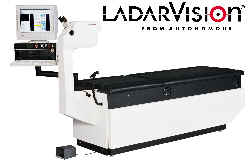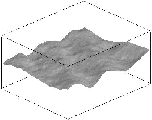Autonomous
LADARVision Laser System

Overall
Rating:
A
Overview:
Autonomous LADARVision is unquestionably one of the most sophisticated
and precise laser systems available today.
Accuracy and reproducibility of the Autonomous laser technology is
unparalleled in the industry by virtue of the highly advanced laser radar
tracking system incorporated into the laser platform. In fact, the Autonomous corporation, in the development
of its laser system, drew heavily from technology developed by NASA for
high-speed space docking as well as missile tracking technology generated by the
Strategic Defense Initiative (Star WARS) specifically for Ballistic Missile
Defense.
Eye
Tracking Technology:
Clinical studies with older laser platforms had clearly demonstrated that
poor patient fixation during excimer laser surgery due to voluntary or
involuntary eye movements could result in decentered treatments and suboptimal
surgical results. Eye tracking
technology eliminates surgical errors related to patient eye movement or
movements of the patient’s head related to rapid heart pulse rate or deep
breathing. Applying Doppler and range imaging laser radar to this
problem ultimately allowed Autonomous to
become the industry leader in the arena of excimer laser technology that tracked
the human eye in real time during a surgical procedure.
No other laser system in the world compares in speed, safety and accuracy
to the platform developed by the Autonomous research team.
Although
other laser systems have developed eye-tracking systems, only Autonomous has a
tracking system that measures eye movement 4,000 times each second and is
capable of following patient eye movements regardless of how rapid or erratic
they may be.
Advantages:
- Advanced
active laser radar eye tracker that electronically “freezes” the eye so
that any voluntary or involuntary patient eye movements are precisely
controlled.
- Successful
laser application does not rely on the patient’s ability to hold his eye
perfectly still. Therefore the
patient can relax and proceed with the laser procedure with the confidence
and the assurance that the laser will respond to any and all eye or body
movements.
- Tracker
technology virtually eliminates the possibility for debentured laser
treatments caused by surgeon error or poor patient fixation.
- Rigorously
tested and approved by the US FDA providing patients with the assurance of
product accuracy, safety and reliability.
- One
of the smoothest ablation profiles in the industry (see photograph). It is
well understood by medical researchers that a rougher surface stimulates a
more vigorous healing response by the body resulting in irregular healing,
optical aberrations, poorer predictability and refractive inaccuracies.
As a result, there is a complete consensus of opinion in the medical
community that “smoother is better”.
- Less
aggressive wound healing resulting in more accurate and predictable results
- Smallest
laser spot size in the industry. Smaller
laser spot improves resolution of the laser treatment providing higher
definition and superior optical clarity.
- Small
laser spot size allows for maximal tissue thermal relaxation between
laser pulses resulting in less tissue damage and therefore superior
outcomes. Studies indicate that
less tissue damage appears to contribute to enhanced long term healing
and superior adhesion of the LASIK flap to the cornea.
- Small
spot size scanning beam platform allows for customized ablation profiles
allowing the surgeon to treat the widest range of refractive errors and to
properly re-contour even the most complex refractive errors or corneal
irregularities.
- Scanning
beam allows for treatments of up to 10 mm in diameter – the largest
optical zone in the industry thereby significantly reducing the risk for
nighttime glare or halos.
- Able
to compensate for rotational eye movements during the laser procedure thereby assuring significantly more
accurate correction of astigmatism. Autonomous
is the only laser system designed with this software feature.
- The
Autonomous eye tracker system is an ideal system for treating farsightedness
and astigmatism because the laser treatment times for this type of
refractive error requires longer treatment times.
During these longer treatments the Autonomous eye tracker accurately
follows any eye movement that may be due to patient fatigue or poor fixation
and provides assurance that each laser pulse is placed accurately.
- The
only laser system with “hinge” protection software capabilities
reducing the chance for laser damage to the hinge area of the corneal flap
during LASIK surgery.
- Little
if any concern for central “islands” or surface irregularities due to
poor laser beam homogeneity, laser “plume” shadowing or corneal fluid
migration problems that chronically plague broad beam laser technology.
- Leads
the industry in the ability to provide exquisitely accurate enhancement
capabilities for all types of under or over corrections with or without
astigmatism. This ability enables the surgeon to fine tune or “enhance”
small amounts of residual refractive error providing the surgeon and the
patient with more assurance that the final uncorrected vision will be
similar to their pre-operative glasses or contact lenses.
- Minimal
acoustic shock wave damage compared to other laser systems resulting in a
higher level of safety to the crystalline lens, retina, and other delicate
eye structures located deeper in the eye.
- “Intelligent”
laser programming features virtually eliminate any risk for operator
transcription or programming errors.
- Custom
ablations may allow for “super vision” by eliminating more complex
optical aberrations from the eye thereby making the eye’s optical system
even better than “normal”. This
potential is not possible with other less advanced laser systems.
 Autonomous
Ablation Profile
Autonomous
Ablation Profile
Disadvantages:
Compare lasers
Compare Laser Eye Surgery Systems
Many people are surprised to learn that all laser systems are not the same.
They all use laser beams to reshape the cornea. But there are important
differences in technology from one system to another. Because these
differences could affect the laser eye surgery procedure, it's important to
understand
why the technology matters.
These charts show you some of the ways that laser systems differ from each
other. Here, we list the features of the most commonly used systems in the
U.S.
Table 1:
All laser systems must be approved by the Food and Drug
Administration (FDA) to treat specific vision problems. The following chart
outlines current laser approvals; however, it does not list the specific
treatment ranges. This information can be found on the section of the FDA's
site on
LASIK
surgery.
Table 2: Laser Systems and the Specific Vision Problems They Can Correct

For More Information...
The section of the FDA's site on LASIK surgery explains the
indications for which all lasers are approved in the United States.
* Sunrise LTK System and Hyperion are trademarks of Sunrise Technologies
International Co.
* LaserSight, LSX, LaserScan are registered trademarks of LaserSight
Technologies Inc.
* Star is a trademark of VISX Inc.
* Technolas is a registered trademark of Bausch & Lomb Inc.
* Nidek is a registered trademark of Nidek Co., Ltd. Corp.
* VISX is a registered trademark of VISX, Inc.
Link
to Autonomous Web Site – www.autonomous.com


![]()